Post-Settlement Integration Challenges of Refugees in Australia
VerifiedAdded on 2023/06/03
|9
|4075
|391
Essay
AI Summary
This essay critically analyzes the post-settlement and integration challenges faced by refugees and their families in Australia. It begins by highlighting the global refugee crisis and Australia's asylum policies. The paper discusses key challenges such as employment, housing, and access to education, elaborating on issues like language barriers, cultural differences, racism, and the recognition of overseas qualifications. It also examines the Australian government's initiatives to address these challenges, including housing support programs and efforts to improve access to educational facilities. The essay emphasizes the importance of affordable housing, secure employment, and inclusive education in facilitating successful integration for refugees in Australia.
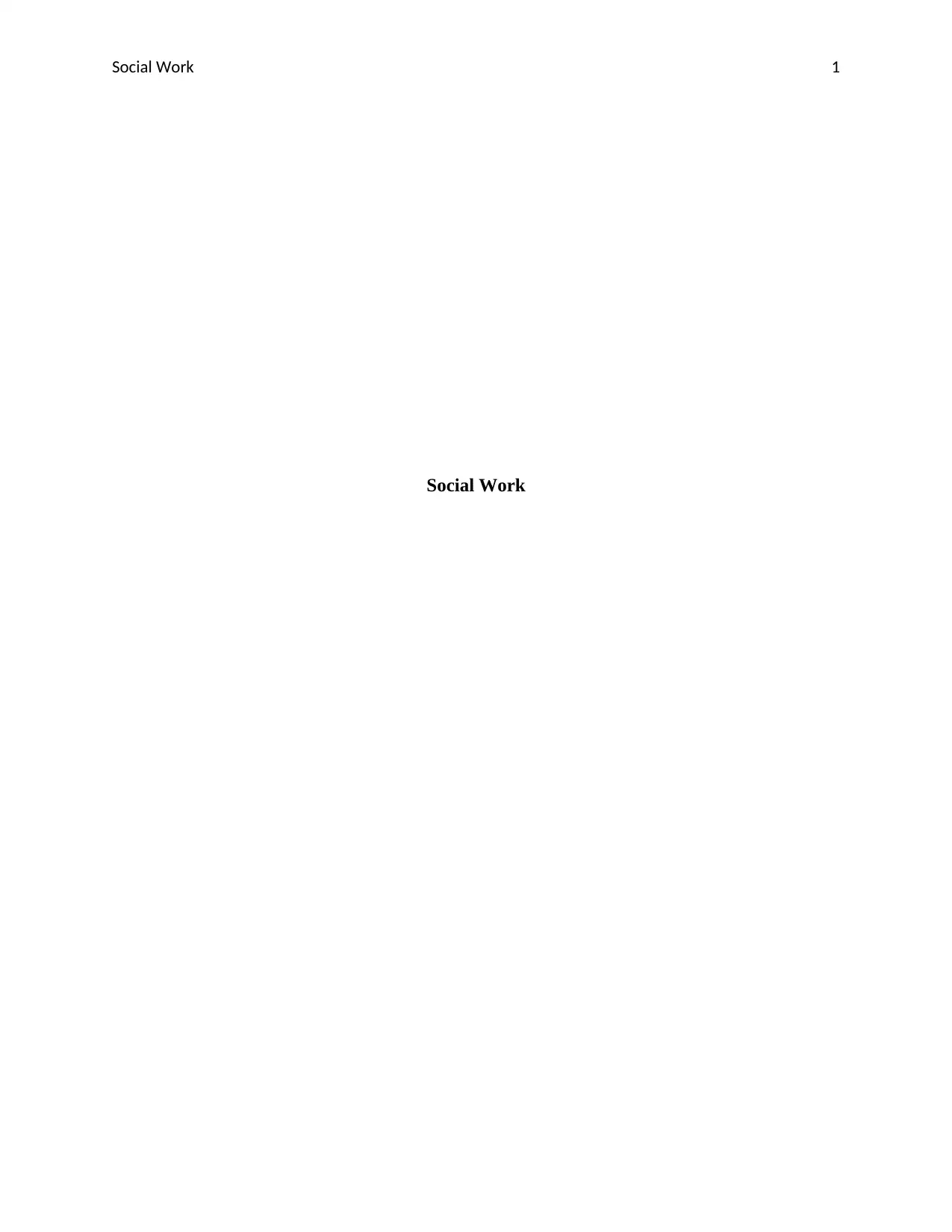
Social Work 1
Social Work
Social Work
Paraphrase This Document
Need a fresh take? Get an instant paraphrase of this document with our AI Paraphraser
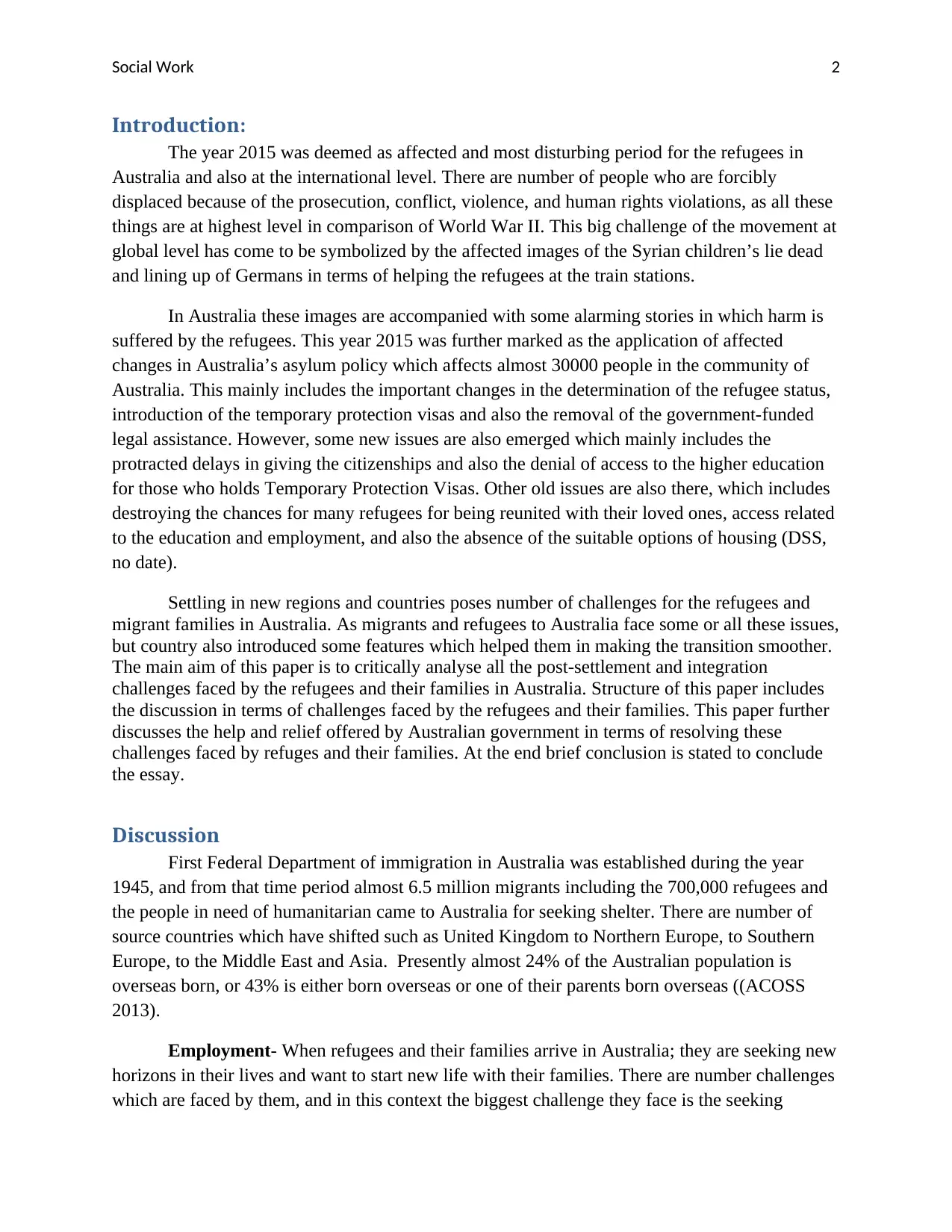
Social Work 2
Introduction:
The year 2015 was deemed as affected and most disturbing period for the refugees in
Australia and also at the international level. There are number of people who are forcibly
displaced because of the prosecution, conflict, violence, and human rights violations, as all these
things are at highest level in comparison of World War II. This big challenge of the movement at
global level has come to be symbolized by the affected images of the Syrian children’s lie dead
and lining up of Germans in terms of helping the refugees at the train stations.
In Australia these images are accompanied with some alarming stories in which harm is
suffered by the refugees. This year 2015 was further marked as the application of affected
changes in Australia’s asylum policy which affects almost 30000 people in the community of
Australia. This mainly includes the important changes in the determination of the refugee status,
introduction of the temporary protection visas and also the removal of the government-funded
legal assistance. However, some new issues are also emerged which mainly includes the
protracted delays in giving the citizenships and also the denial of access to the higher education
for those who holds Temporary Protection Visas. Other old issues are also there, which includes
destroying the chances for many refugees for being reunited with their loved ones, access related
to the education and employment, and also the absence of the suitable options of housing (DSS,
no date).
Settling in new regions and countries poses number of challenges for the refugees and
migrant families in Australia. As migrants and refugees to Australia face some or all these issues,
but country also introduced some features which helped them in making the transition smoother.
The main aim of this paper is to critically analyse all the post-settlement and integration
challenges faced by the refugees and their families in Australia. Structure of this paper includes
the discussion in terms of challenges faced by the refugees and their families. This paper further
discusses the help and relief offered by Australian government in terms of resolving these
challenges faced by refuges and their families. At the end brief conclusion is stated to conclude
the essay.
Discussion
First Federal Department of immigration in Australia was established during the year
1945, and from that time period almost 6.5 million migrants including the 700,000 refugees and
the people in need of humanitarian came to Australia for seeking shelter. There are number of
source countries which have shifted such as United Kingdom to Northern Europe, to Southern
Europe, to the Middle East and Asia. Presently almost 24% of the Australian population is
overseas born, or 43% is either born overseas or one of their parents born overseas ((ACOSS
2013).
Employment- When refugees and their families arrive in Australia; they are seeking new
horizons in their lives and want to start new life with their families. There are number challenges
which are faced by them, and in this context the biggest challenge they face is the seeking
Introduction:
The year 2015 was deemed as affected and most disturbing period for the refugees in
Australia and also at the international level. There are number of people who are forcibly
displaced because of the prosecution, conflict, violence, and human rights violations, as all these
things are at highest level in comparison of World War II. This big challenge of the movement at
global level has come to be symbolized by the affected images of the Syrian children’s lie dead
and lining up of Germans in terms of helping the refugees at the train stations.
In Australia these images are accompanied with some alarming stories in which harm is
suffered by the refugees. This year 2015 was further marked as the application of affected
changes in Australia’s asylum policy which affects almost 30000 people in the community of
Australia. This mainly includes the important changes in the determination of the refugee status,
introduction of the temporary protection visas and also the removal of the government-funded
legal assistance. However, some new issues are also emerged which mainly includes the
protracted delays in giving the citizenships and also the denial of access to the higher education
for those who holds Temporary Protection Visas. Other old issues are also there, which includes
destroying the chances for many refugees for being reunited with their loved ones, access related
to the education and employment, and also the absence of the suitable options of housing (DSS,
no date).
Settling in new regions and countries poses number of challenges for the refugees and
migrant families in Australia. As migrants and refugees to Australia face some or all these issues,
but country also introduced some features which helped them in making the transition smoother.
The main aim of this paper is to critically analyse all the post-settlement and integration
challenges faced by the refugees and their families in Australia. Structure of this paper includes
the discussion in terms of challenges faced by the refugees and their families. This paper further
discusses the help and relief offered by Australian government in terms of resolving these
challenges faced by refuges and their families. At the end brief conclusion is stated to conclude
the essay.
Discussion
First Federal Department of immigration in Australia was established during the year
1945, and from that time period almost 6.5 million migrants including the 700,000 refugees and
the people in need of humanitarian came to Australia for seeking shelter. There are number of
source countries which have shifted such as United Kingdom to Northern Europe, to Southern
Europe, to the Middle East and Asia. Presently almost 24% of the Australian population is
overseas born, or 43% is either born overseas or one of their parents born overseas ((ACOSS
2013).
Employment- When refugees and their families arrive in Australia; they are seeking new
horizons in their lives and want to start new life with their families. There are number challenges
which are faced by them, and in this context the biggest challenge they face is the seeking
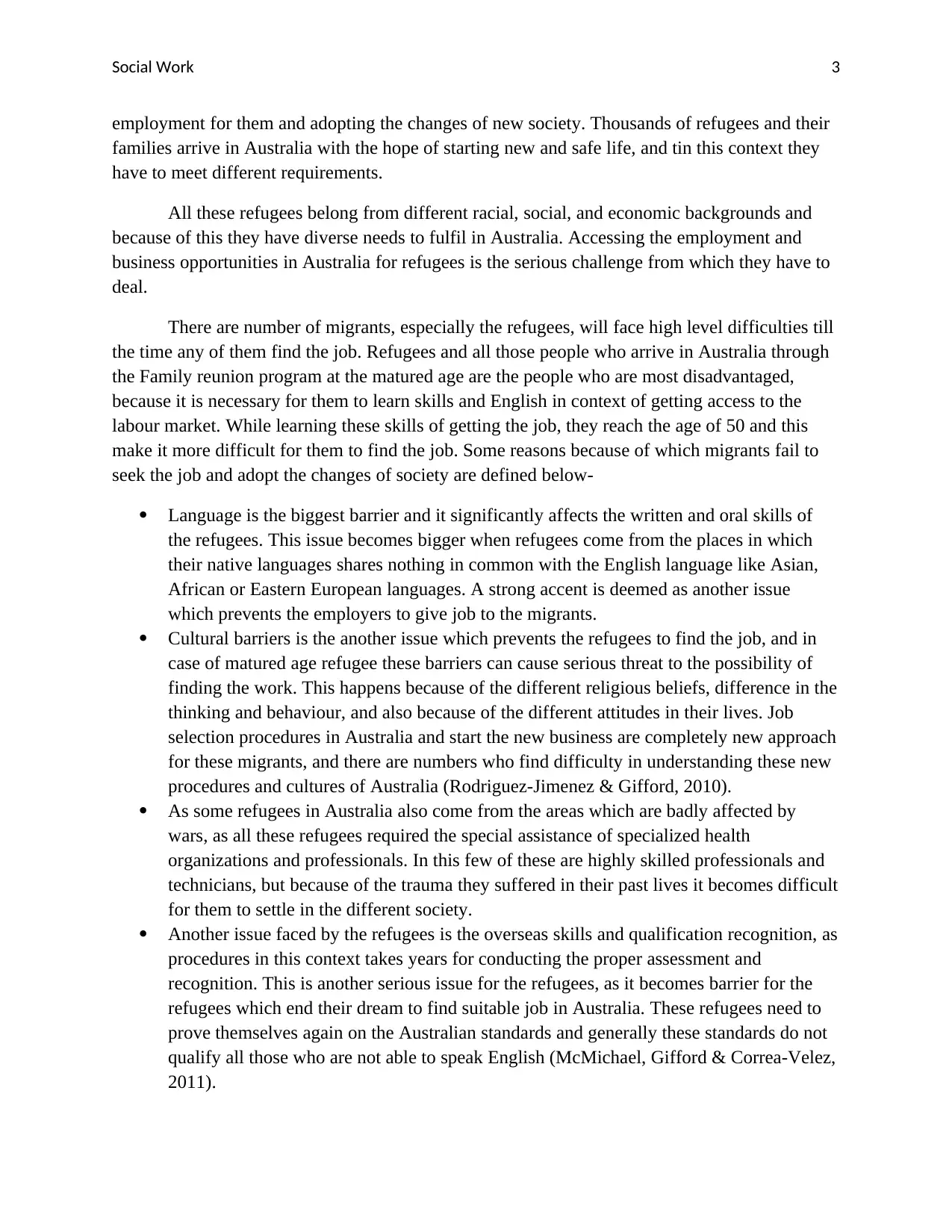
Social Work 3
employment for them and adopting the changes of new society. Thousands of refugees and their
families arrive in Australia with the hope of starting new and safe life, and tin this context they
have to meet different requirements.
All these refugees belong from different racial, social, and economic backgrounds and
because of this they have diverse needs to fulfil in Australia. Accessing the employment and
business opportunities in Australia for refugees is the serious challenge from which they have to
deal.
There are number of migrants, especially the refugees, will face high level difficulties till
the time any of them find the job. Refugees and all those people who arrive in Australia through
the Family reunion program at the matured age are the people who are most disadvantaged,
because it is necessary for them to learn skills and English in context of getting access to the
labour market. While learning these skills of getting the job, they reach the age of 50 and this
make it more difficult for them to find the job. Some reasons because of which migrants fail to
seek the job and adopt the changes of society are defined below-
Language is the biggest barrier and it significantly affects the written and oral skills of
the refugees. This issue becomes bigger when refugees come from the places in which
their native languages shares nothing in common with the English language like Asian,
African or Eastern European languages. A strong accent is deemed as another issue
which prevents the employers to give job to the migrants.
Cultural barriers is the another issue which prevents the refugees to find the job, and in
case of matured age refugee these barriers can cause serious threat to the possibility of
finding the work. This happens because of the different religious beliefs, difference in the
thinking and behaviour, and also because of the different attitudes in their lives. Job
selection procedures in Australia and start the new business are completely new approach
for these migrants, and there are numbers who find difficulty in understanding these new
procedures and cultures of Australia (Rodriguez-Jimenez & Gifford, 2010).
As some refugees in Australia also come from the areas which are badly affected by
wars, as all these refugees required the special assistance of specialized health
organizations and professionals. In this few of these are highly skilled professionals and
technicians, but because of the trauma they suffered in their past lives it becomes difficult
for them to settle in the different society.
Another issue faced by the refugees is the overseas skills and qualification recognition, as
procedures in this context takes years for conducting the proper assessment and
recognition. This is another serious issue for the refugees, as it becomes barrier for the
refugees which end their dream to find suitable job in Australia. These refugees need to
prove themselves again on the Australian standards and generally these standards do not
qualify all those who are not able to speak English (McMichael, Gifford & Correa-Velez,
2011).
employment for them and adopting the changes of new society. Thousands of refugees and their
families arrive in Australia with the hope of starting new and safe life, and tin this context they
have to meet different requirements.
All these refugees belong from different racial, social, and economic backgrounds and
because of this they have diverse needs to fulfil in Australia. Accessing the employment and
business opportunities in Australia for refugees is the serious challenge from which they have to
deal.
There are number of migrants, especially the refugees, will face high level difficulties till
the time any of them find the job. Refugees and all those people who arrive in Australia through
the Family reunion program at the matured age are the people who are most disadvantaged,
because it is necessary for them to learn skills and English in context of getting access to the
labour market. While learning these skills of getting the job, they reach the age of 50 and this
make it more difficult for them to find the job. Some reasons because of which migrants fail to
seek the job and adopt the changes of society are defined below-
Language is the biggest barrier and it significantly affects the written and oral skills of
the refugees. This issue becomes bigger when refugees come from the places in which
their native languages shares nothing in common with the English language like Asian,
African or Eastern European languages. A strong accent is deemed as another issue
which prevents the employers to give job to the migrants.
Cultural barriers is the another issue which prevents the refugees to find the job, and in
case of matured age refugee these barriers can cause serious threat to the possibility of
finding the work. This happens because of the different religious beliefs, difference in the
thinking and behaviour, and also because of the different attitudes in their lives. Job
selection procedures in Australia and start the new business are completely new approach
for these migrants, and there are numbers who find difficulty in understanding these new
procedures and cultures of Australia (Rodriguez-Jimenez & Gifford, 2010).
As some refugees in Australia also come from the areas which are badly affected by
wars, as all these refugees required the special assistance of specialized health
organizations and professionals. In this few of these are highly skilled professionals and
technicians, but because of the trauma they suffered in their past lives it becomes difficult
for them to settle in the different society.
Another issue faced by the refugees is the overseas skills and qualification recognition, as
procedures in this context takes years for conducting the proper assessment and
recognition. This is another serious issue for the refugees, as it becomes barrier for the
refugees which end their dream to find suitable job in Australia. These refugees need to
prove themselves again on the Australian standards and generally these standards do not
qualify all those who are not able to speak English (McMichael, Gifford & Correa-Velez,
2011).
⊘ This is a preview!⊘
Do you want full access?
Subscribe today to unlock all pages.

Trusted by 1+ million students worldwide
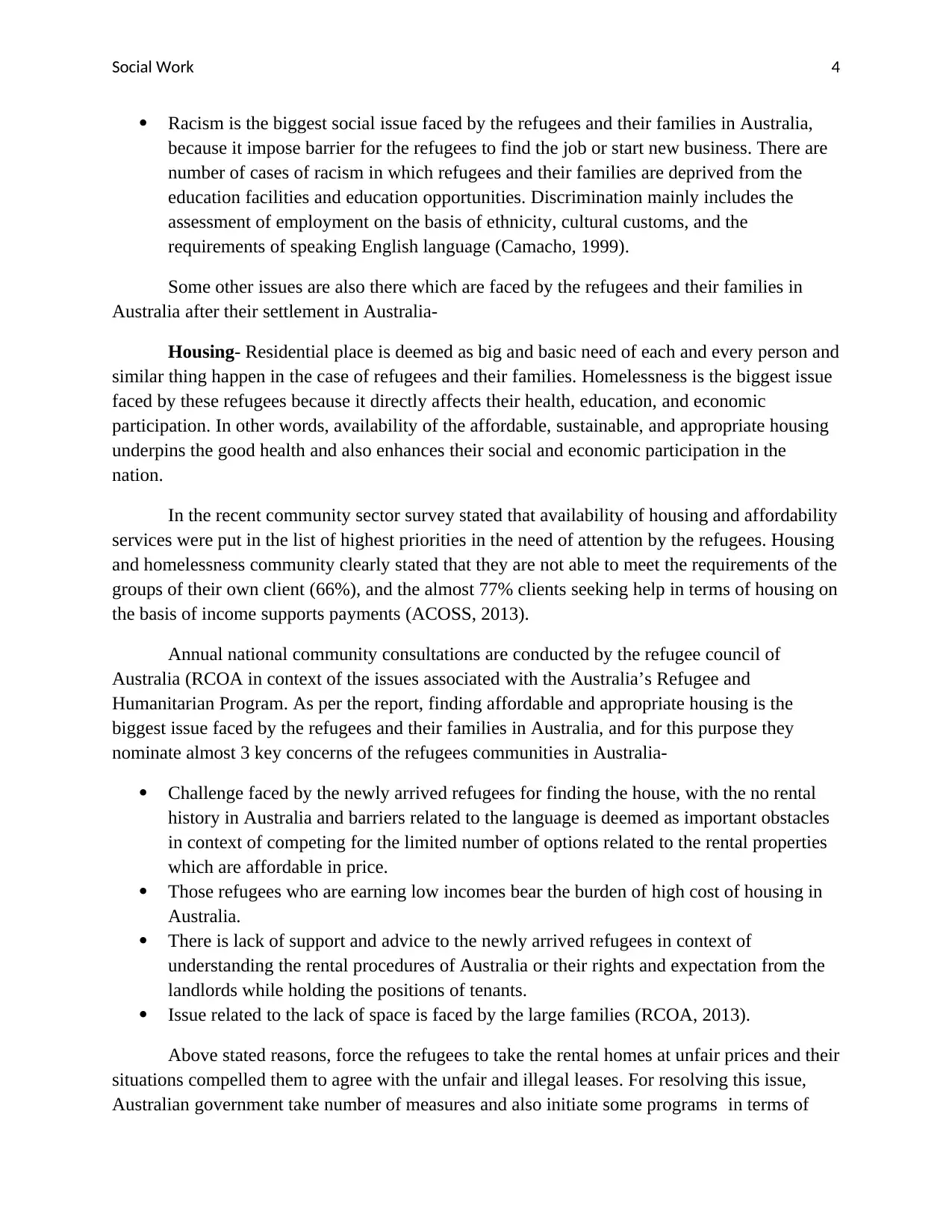
Social Work 4
Racism is the biggest social issue faced by the refugees and their families in Australia,
because it impose barrier for the refugees to find the job or start new business. There are
number of cases of racism in which refugees and their families are deprived from the
education facilities and education opportunities. Discrimination mainly includes the
assessment of employment on the basis of ethnicity, cultural customs, and the
requirements of speaking English language (Camacho, 1999).
Some other issues are also there which are faced by the refugees and their families in
Australia after their settlement in Australia-
Housing- Residential place is deemed as big and basic need of each and every person and
similar thing happen in the case of refugees and their families. Homelessness is the biggest issue
faced by these refugees because it directly affects their health, education, and economic
participation. In other words, availability of the affordable, sustainable, and appropriate housing
underpins the good health and also enhances their social and economic participation in the
nation.
In the recent community sector survey stated that availability of housing and affordability
services were put in the list of highest priorities in the need of attention by the refugees. Housing
and homelessness community clearly stated that they are not able to meet the requirements of the
groups of their own client (66%), and the almost 77% clients seeking help in terms of housing on
the basis of income supports payments (ACOSS, 2013).
Annual national community consultations are conducted by the refugee council of
Australia (RCOA in context of the issues associated with the Australia’s Refugee and
Humanitarian Program. As per the report, finding affordable and appropriate housing is the
biggest issue faced by the refugees and their families in Australia, and for this purpose they
nominate almost 3 key concerns of the refugees communities in Australia-
Challenge faced by the newly arrived refugees for finding the house, with the no rental
history in Australia and barriers related to the language is deemed as important obstacles
in context of competing for the limited number of options related to the rental properties
which are affordable in price.
Those refugees who are earning low incomes bear the burden of high cost of housing in
Australia.
There is lack of support and advice to the newly arrived refugees in context of
understanding the rental procedures of Australia or their rights and expectation from the
landlords while holding the positions of tenants.
Issue related to the lack of space is faced by the large families (RCOA, 2013).
Above stated reasons, force the refugees to take the rental homes at unfair prices and their
situations compelled them to agree with the unfair and illegal leases. For resolving this issue,
Australian government take number of measures and also initiate some programs in terms of
Racism is the biggest social issue faced by the refugees and their families in Australia,
because it impose barrier for the refugees to find the job or start new business. There are
number of cases of racism in which refugees and their families are deprived from the
education facilities and education opportunities. Discrimination mainly includes the
assessment of employment on the basis of ethnicity, cultural customs, and the
requirements of speaking English language (Camacho, 1999).
Some other issues are also there which are faced by the refugees and their families in
Australia after their settlement in Australia-
Housing- Residential place is deemed as big and basic need of each and every person and
similar thing happen in the case of refugees and their families. Homelessness is the biggest issue
faced by these refugees because it directly affects their health, education, and economic
participation. In other words, availability of the affordable, sustainable, and appropriate housing
underpins the good health and also enhances their social and economic participation in the
nation.
In the recent community sector survey stated that availability of housing and affordability
services were put in the list of highest priorities in the need of attention by the refugees. Housing
and homelessness community clearly stated that they are not able to meet the requirements of the
groups of their own client (66%), and the almost 77% clients seeking help in terms of housing on
the basis of income supports payments (ACOSS, 2013).
Annual national community consultations are conducted by the refugee council of
Australia (RCOA in context of the issues associated with the Australia’s Refugee and
Humanitarian Program. As per the report, finding affordable and appropriate housing is the
biggest issue faced by the refugees and their families in Australia, and for this purpose they
nominate almost 3 key concerns of the refugees communities in Australia-
Challenge faced by the newly arrived refugees for finding the house, with the no rental
history in Australia and barriers related to the language is deemed as important obstacles
in context of competing for the limited number of options related to the rental properties
which are affordable in price.
Those refugees who are earning low incomes bear the burden of high cost of housing in
Australia.
There is lack of support and advice to the newly arrived refugees in context of
understanding the rental procedures of Australia or their rights and expectation from the
landlords while holding the positions of tenants.
Issue related to the lack of space is faced by the large families (RCOA, 2013).
Above stated reasons, force the refugees to take the rental homes at unfair prices and their
situations compelled them to agree with the unfair and illegal leases. For resolving this issue,
Australian government take number of measures and also initiate some programs in terms of
Paraphrase This Document
Need a fresh take? Get an instant paraphrase of this document with our AI Paraphraser
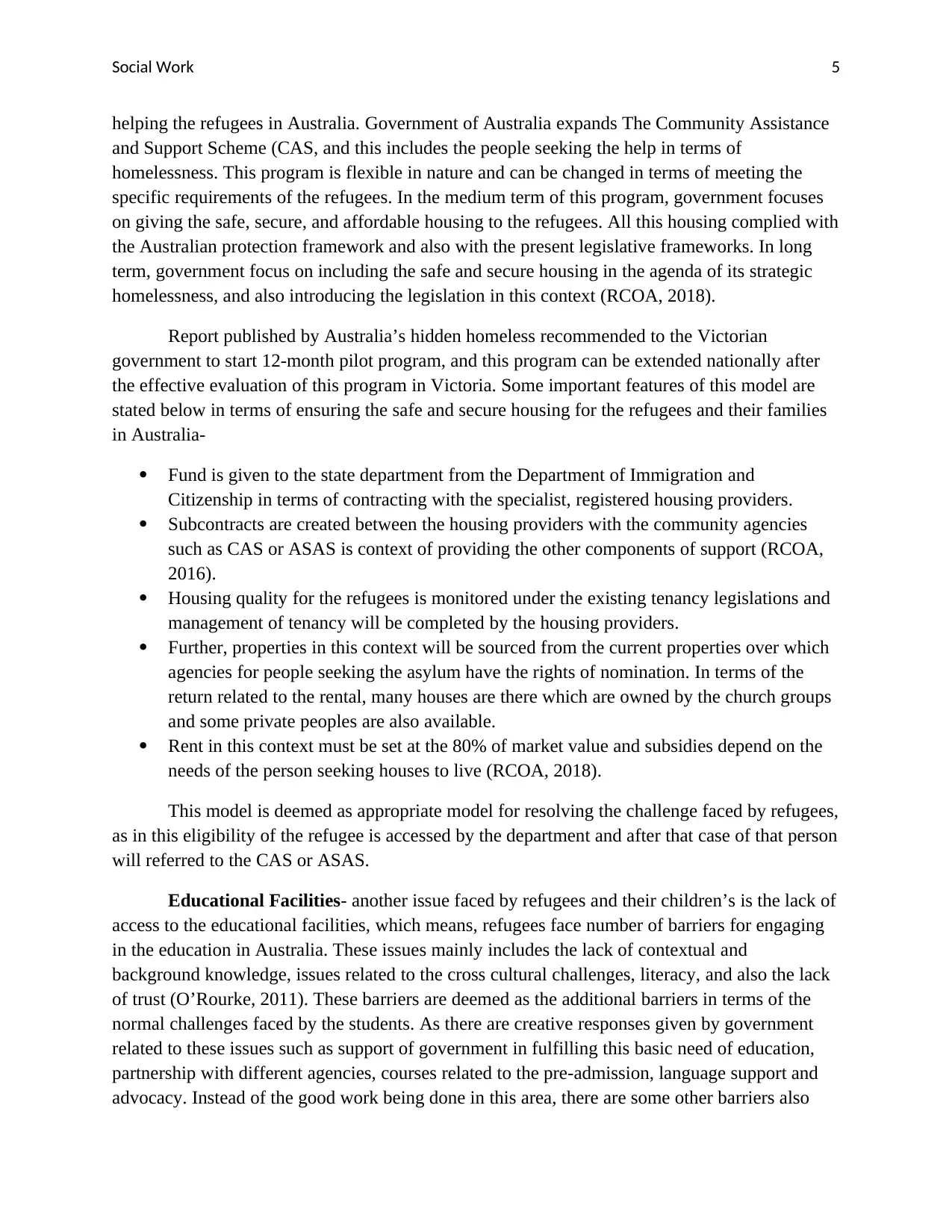
Social Work 5
helping the refugees in Australia. Government of Australia expands The Community Assistance
and Support Scheme (CAS, and this includes the people seeking the help in terms of
homelessness. This program is flexible in nature and can be changed in terms of meeting the
specific requirements of the refugees. In the medium term of this program, government focuses
on giving the safe, secure, and affordable housing to the refugees. All this housing complied with
the Australian protection framework and also with the present legislative frameworks. In long
term, government focus on including the safe and secure housing in the agenda of its strategic
homelessness, and also introducing the legislation in this context (RCOA, 2018).
Report published by Australia’s hidden homeless recommended to the Victorian
government to start 12-month pilot program, and this program can be extended nationally after
the effective evaluation of this program in Victoria. Some important features of this model are
stated below in terms of ensuring the safe and secure housing for the refugees and their families
in Australia-
Fund is given to the state department from the Department of Immigration and
Citizenship in terms of contracting with the specialist, registered housing providers.
Subcontracts are created between the housing providers with the community agencies
such as CAS or ASAS is context of providing the other components of support (RCOA,
2016).
Housing quality for the refugees is monitored under the existing tenancy legislations and
management of tenancy will be completed by the housing providers.
Further, properties in this context will be sourced from the current properties over which
agencies for people seeking the asylum have the rights of nomination. In terms of the
return related to the rental, many houses are there which are owned by the church groups
and some private peoples are also available.
Rent in this context must be set at the 80% of market value and subsidies depend on the
needs of the person seeking houses to live (RCOA, 2018).
This model is deemed as appropriate model for resolving the challenge faced by refugees,
as in this eligibility of the refugee is accessed by the department and after that case of that person
will referred to the CAS or ASAS.
Educational Facilities- another issue faced by refugees and their children’s is the lack of
access to the educational facilities, which means, refugees face number of barriers for engaging
in the education in Australia. These issues mainly includes the lack of contextual and
background knowledge, issues related to the cross cultural challenges, literacy, and also the lack
of trust (O’Rourke, 2011). These barriers are deemed as the additional barriers in terms of the
normal challenges faced by the students. As there are creative responses given by government
related to these issues such as support of government in fulfilling this basic need of education,
partnership with different agencies, courses related to the pre-admission, language support and
advocacy. Instead of the good work being done in this area, there are some other barriers also
helping the refugees in Australia. Government of Australia expands The Community Assistance
and Support Scheme (CAS, and this includes the people seeking the help in terms of
homelessness. This program is flexible in nature and can be changed in terms of meeting the
specific requirements of the refugees. In the medium term of this program, government focuses
on giving the safe, secure, and affordable housing to the refugees. All this housing complied with
the Australian protection framework and also with the present legislative frameworks. In long
term, government focus on including the safe and secure housing in the agenda of its strategic
homelessness, and also introducing the legislation in this context (RCOA, 2018).
Report published by Australia’s hidden homeless recommended to the Victorian
government to start 12-month pilot program, and this program can be extended nationally after
the effective evaluation of this program in Victoria. Some important features of this model are
stated below in terms of ensuring the safe and secure housing for the refugees and their families
in Australia-
Fund is given to the state department from the Department of Immigration and
Citizenship in terms of contracting with the specialist, registered housing providers.
Subcontracts are created between the housing providers with the community agencies
such as CAS or ASAS is context of providing the other components of support (RCOA,
2016).
Housing quality for the refugees is monitored under the existing tenancy legislations and
management of tenancy will be completed by the housing providers.
Further, properties in this context will be sourced from the current properties over which
agencies for people seeking the asylum have the rights of nomination. In terms of the
return related to the rental, many houses are there which are owned by the church groups
and some private peoples are also available.
Rent in this context must be set at the 80% of market value and subsidies depend on the
needs of the person seeking houses to live (RCOA, 2018).
This model is deemed as appropriate model for resolving the challenge faced by refugees,
as in this eligibility of the refugee is accessed by the department and after that case of that person
will referred to the CAS or ASAS.
Educational Facilities- another issue faced by refugees and their children’s is the lack of
access to the educational facilities, which means, refugees face number of barriers for engaging
in the education in Australia. These issues mainly includes the lack of contextual and
background knowledge, issues related to the cross cultural challenges, literacy, and also the lack
of trust (O’Rourke, 2011). These barriers are deemed as the additional barriers in terms of the
normal challenges faced by the students. As there are creative responses given by government
related to these issues such as support of government in fulfilling this basic need of education,
partnership with different agencies, courses related to the pre-admission, language support and
advocacy. Instead of the good work being done in this area, there are some other barriers also
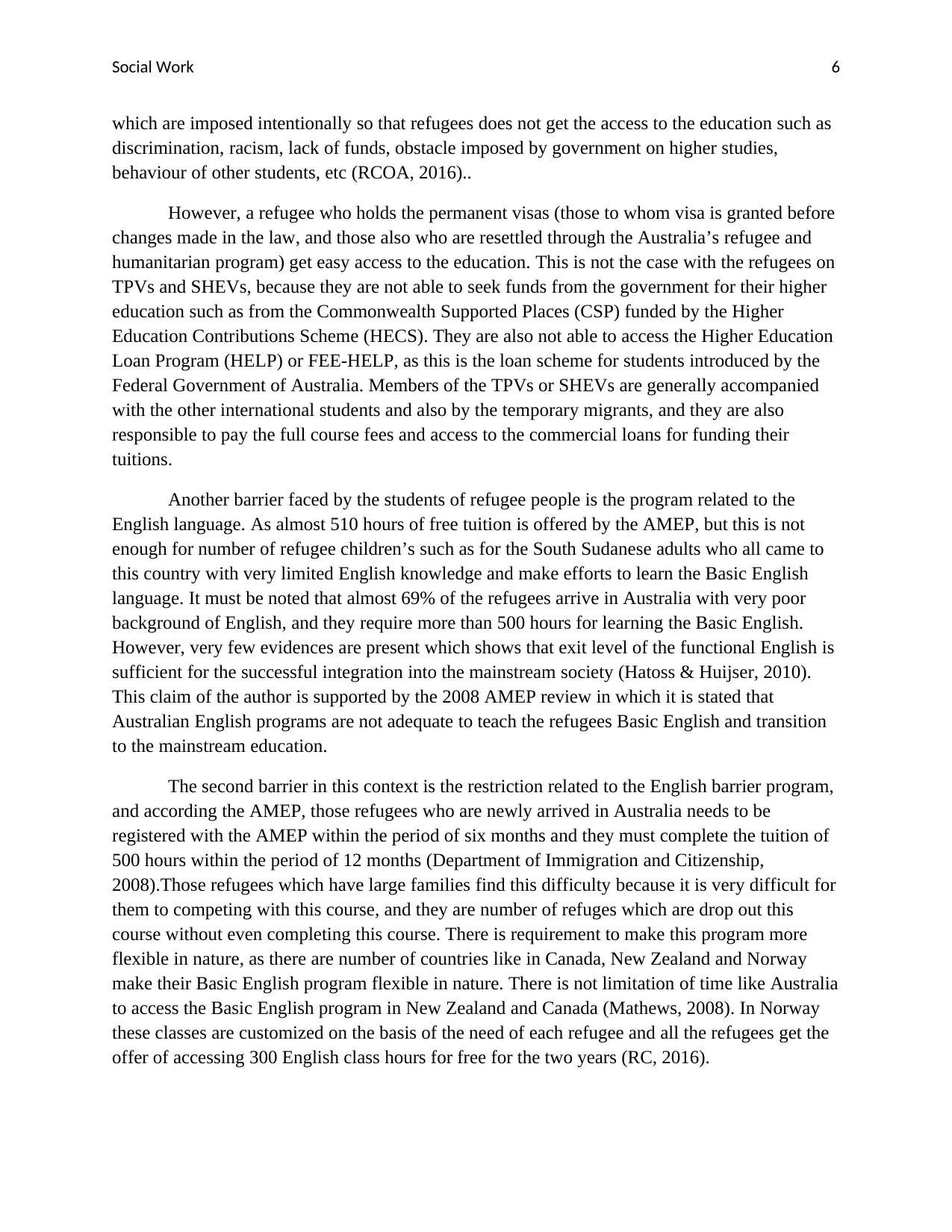
Social Work 6
which are imposed intentionally so that refugees does not get the access to the education such as
discrimination, racism, lack of funds, obstacle imposed by government on higher studies,
behaviour of other students, etc (RCOA, 2016)..
However, a refugee who holds the permanent visas (those to whom visa is granted before
changes made in the law, and those also who are resettled through the Australia’s refugee and
humanitarian program) get easy access to the education. This is not the case with the refugees on
TPVs and SHEVs, because they are not able to seek funds from the government for their higher
education such as from the Commonwealth Supported Places (CSP) funded by the Higher
Education Contributions Scheme (HECS). They are also not able to access the Higher Education
Loan Program (HELP) or FEE-HELP, as this is the loan scheme for students introduced by the
Federal Government of Australia. Members of the TPVs or SHEVs are generally accompanied
with the other international students and also by the temporary migrants, and they are also
responsible to pay the full course fees and access to the commercial loans for funding their
tuitions.
Another barrier faced by the students of refugee people is the program related to the
English language. As almost 510 hours of free tuition is offered by the AMEP, but this is not
enough for number of refugee children’s such as for the South Sudanese adults who all came to
this country with very limited English knowledge and make efforts to learn the Basic English
language. It must be noted that almost 69% of the refugees arrive in Australia with very poor
background of English, and they require more than 500 hours for learning the Basic English.
However, very few evidences are present which shows that exit level of the functional English is
sufficient for the successful integration into the mainstream society (Hatoss & Huijser, 2010).
This claim of the author is supported by the 2008 AMEP review in which it is stated that
Australian English programs are not adequate to teach the refugees Basic English and transition
to the mainstream education.
The second barrier in this context is the restriction related to the English barrier program,
and according the AMEP, those refugees who are newly arrived in Australia needs to be
registered with the AMEP within the period of six months and they must complete the tuition of
500 hours within the period of 12 months (Department of Immigration and Citizenship,
2008).Those refugees which have large families find this difficulty because it is very difficult for
them to competing with this course, and they are number of refuges which are drop out this
course without even completing this course. There is requirement to make this program more
flexible in nature, as there are number of countries like in Canada, New Zealand and Norway
make their Basic English program flexible in nature. There is not limitation of time like Australia
to access the Basic English program in New Zealand and Canada (Mathews, 2008). In Norway
these classes are customized on the basis of the need of each refugee and all the refugees get the
offer of accessing 300 English class hours for free for the two years (RC, 2016).
which are imposed intentionally so that refugees does not get the access to the education such as
discrimination, racism, lack of funds, obstacle imposed by government on higher studies,
behaviour of other students, etc (RCOA, 2016)..
However, a refugee who holds the permanent visas (those to whom visa is granted before
changes made in the law, and those also who are resettled through the Australia’s refugee and
humanitarian program) get easy access to the education. This is not the case with the refugees on
TPVs and SHEVs, because they are not able to seek funds from the government for their higher
education such as from the Commonwealth Supported Places (CSP) funded by the Higher
Education Contributions Scheme (HECS). They are also not able to access the Higher Education
Loan Program (HELP) or FEE-HELP, as this is the loan scheme for students introduced by the
Federal Government of Australia. Members of the TPVs or SHEVs are generally accompanied
with the other international students and also by the temporary migrants, and they are also
responsible to pay the full course fees and access to the commercial loans for funding their
tuitions.
Another barrier faced by the students of refugee people is the program related to the
English language. As almost 510 hours of free tuition is offered by the AMEP, but this is not
enough for number of refugee children’s such as for the South Sudanese adults who all came to
this country with very limited English knowledge and make efforts to learn the Basic English
language. It must be noted that almost 69% of the refugees arrive in Australia with very poor
background of English, and they require more than 500 hours for learning the Basic English.
However, very few evidences are present which shows that exit level of the functional English is
sufficient for the successful integration into the mainstream society (Hatoss & Huijser, 2010).
This claim of the author is supported by the 2008 AMEP review in which it is stated that
Australian English programs are not adequate to teach the refugees Basic English and transition
to the mainstream education.
The second barrier in this context is the restriction related to the English barrier program,
and according the AMEP, those refugees who are newly arrived in Australia needs to be
registered with the AMEP within the period of six months and they must complete the tuition of
500 hours within the period of 12 months (Department of Immigration and Citizenship,
2008).Those refugees which have large families find this difficulty because it is very difficult for
them to competing with this course, and they are number of refuges which are drop out this
course without even completing this course. There is requirement to make this program more
flexible in nature, as there are number of countries like in Canada, New Zealand and Norway
make their Basic English program flexible in nature. There is not limitation of time like Australia
to access the Basic English program in New Zealand and Canada (Mathews, 2008). In Norway
these classes are customized on the basis of the need of each refugee and all the refugees get the
offer of accessing 300 English class hours for free for the two years (RC, 2016).
⊘ This is a preview!⊘
Do you want full access?
Subscribe today to unlock all pages.

Trusted by 1+ million students worldwide
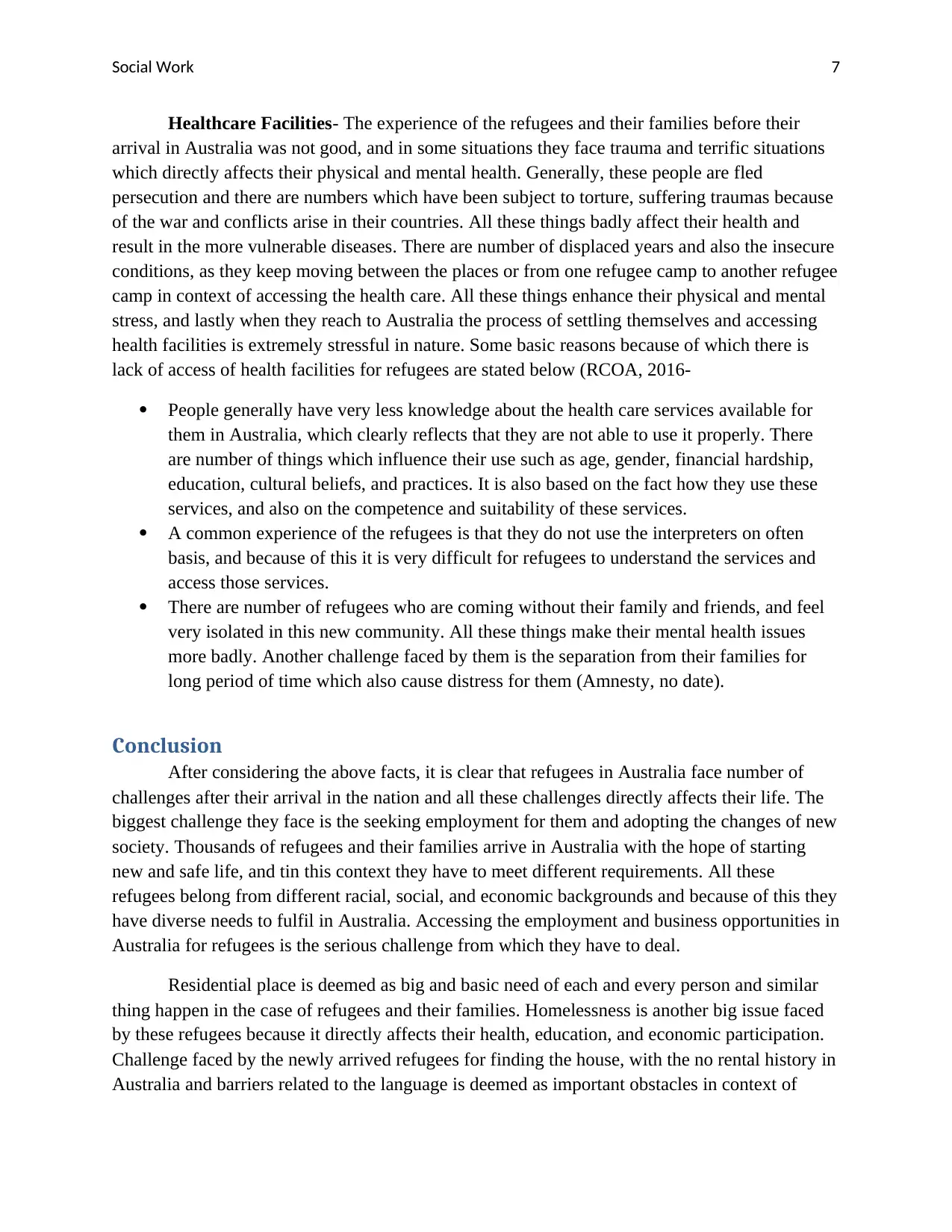
Social Work 7
Healthcare Facilities- The experience of the refugees and their families before their
arrival in Australia was not good, and in some situations they face trauma and terrific situations
which directly affects their physical and mental health. Generally, these people are fled
persecution and there are numbers which have been subject to torture, suffering traumas because
of the war and conflicts arise in their countries. All these things badly affect their health and
result in the more vulnerable diseases. There are number of displaced years and also the insecure
conditions, as they keep moving between the places or from one refugee camp to another refugee
camp in context of accessing the health care. All these things enhance their physical and mental
stress, and lastly when they reach to Australia the process of settling themselves and accessing
health facilities is extremely stressful in nature. Some basic reasons because of which there is
lack of access of health facilities for refugees are stated below (RCOA, 2016-
People generally have very less knowledge about the health care services available for
them in Australia, which clearly reflects that they are not able to use it properly. There
are number of things which influence their use such as age, gender, financial hardship,
education, cultural beliefs, and practices. It is also based on the fact how they use these
services, and also on the competence and suitability of these services.
A common experience of the refugees is that they do not use the interpreters on often
basis, and because of this it is very difficult for refugees to understand the services and
access those services.
There are number of refugees who are coming without their family and friends, and feel
very isolated in this new community. All these things make their mental health issues
more badly. Another challenge faced by them is the separation from their families for
long period of time which also cause distress for them (Amnesty, no date).
Conclusion
After considering the above facts, it is clear that refugees in Australia face number of
challenges after their arrival in the nation and all these challenges directly affects their life. The
biggest challenge they face is the seeking employment for them and adopting the changes of new
society. Thousands of refugees and their families arrive in Australia with the hope of starting
new and safe life, and tin this context they have to meet different requirements. All these
refugees belong from different racial, social, and economic backgrounds and because of this they
have diverse needs to fulfil in Australia. Accessing the employment and business opportunities in
Australia for refugees is the serious challenge from which they have to deal.
Residential place is deemed as big and basic need of each and every person and similar
thing happen in the case of refugees and their families. Homelessness is another big issue faced
by these refugees because it directly affects their health, education, and economic participation.
Challenge faced by the newly arrived refugees for finding the house, with the no rental history in
Australia and barriers related to the language is deemed as important obstacles in context of
Healthcare Facilities- The experience of the refugees and their families before their
arrival in Australia was not good, and in some situations they face trauma and terrific situations
which directly affects their physical and mental health. Generally, these people are fled
persecution and there are numbers which have been subject to torture, suffering traumas because
of the war and conflicts arise in their countries. All these things badly affect their health and
result in the more vulnerable diseases. There are number of displaced years and also the insecure
conditions, as they keep moving between the places or from one refugee camp to another refugee
camp in context of accessing the health care. All these things enhance their physical and mental
stress, and lastly when they reach to Australia the process of settling themselves and accessing
health facilities is extremely stressful in nature. Some basic reasons because of which there is
lack of access of health facilities for refugees are stated below (RCOA, 2016-
People generally have very less knowledge about the health care services available for
them in Australia, which clearly reflects that they are not able to use it properly. There
are number of things which influence their use such as age, gender, financial hardship,
education, cultural beliefs, and practices. It is also based on the fact how they use these
services, and also on the competence and suitability of these services.
A common experience of the refugees is that they do not use the interpreters on often
basis, and because of this it is very difficult for refugees to understand the services and
access those services.
There are number of refugees who are coming without their family and friends, and feel
very isolated in this new community. All these things make their mental health issues
more badly. Another challenge faced by them is the separation from their families for
long period of time which also cause distress for them (Amnesty, no date).
Conclusion
After considering the above facts, it is clear that refugees in Australia face number of
challenges after their arrival in the nation and all these challenges directly affects their life. The
biggest challenge they face is the seeking employment for them and adopting the changes of new
society. Thousands of refugees and their families arrive in Australia with the hope of starting
new and safe life, and tin this context they have to meet different requirements. All these
refugees belong from different racial, social, and economic backgrounds and because of this they
have diverse needs to fulfil in Australia. Accessing the employment and business opportunities in
Australia for refugees is the serious challenge from which they have to deal.
Residential place is deemed as big and basic need of each and every person and similar
thing happen in the case of refugees and their families. Homelessness is another big issue faced
by these refugees because it directly affects their health, education, and economic participation.
Challenge faced by the newly arrived refugees for finding the house, with the no rental history in
Australia and barriers related to the language is deemed as important obstacles in context of
Paraphrase This Document
Need a fresh take? Get an instant paraphrase of this document with our AI Paraphraser
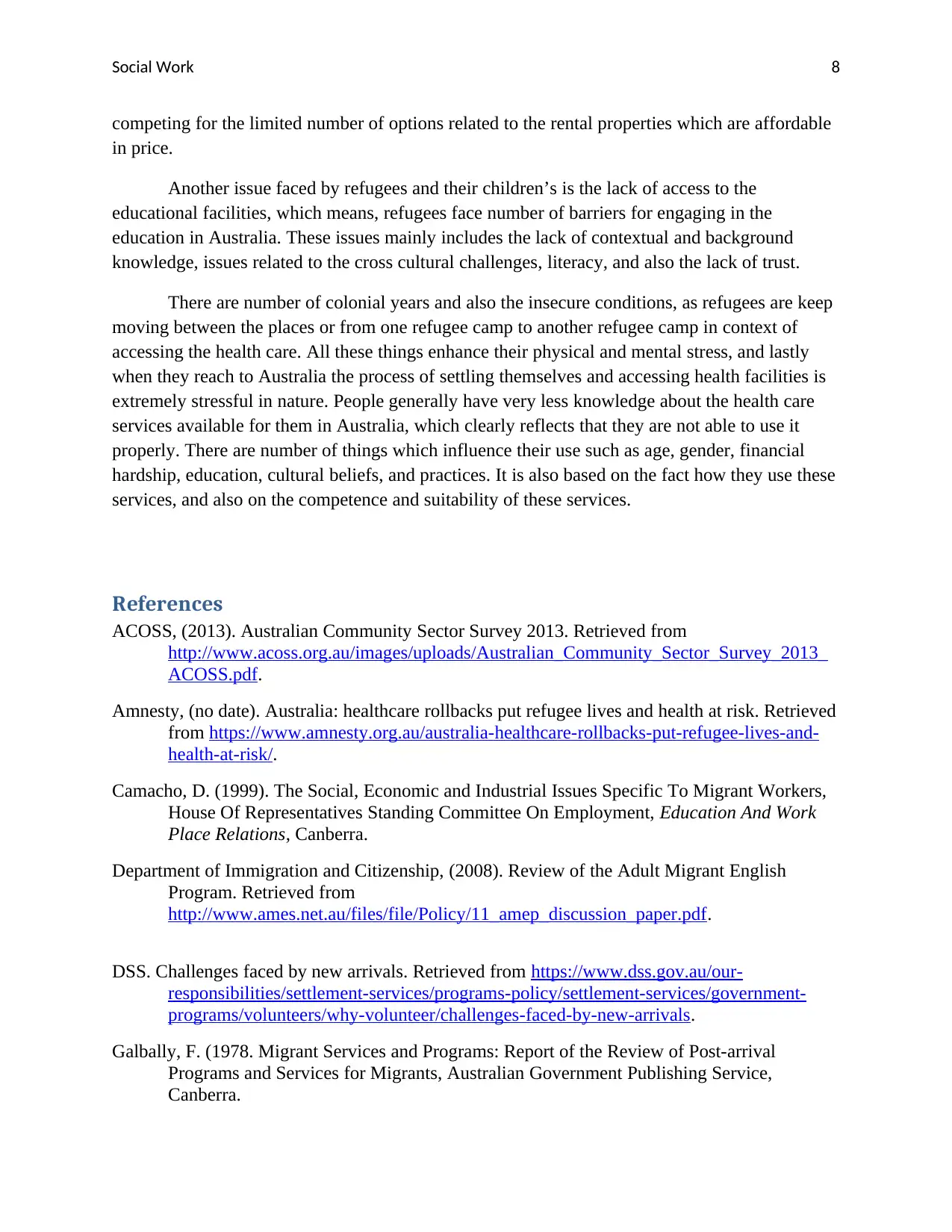
Social Work 8
competing for the limited number of options related to the rental properties which are affordable
in price.
Another issue faced by refugees and their children’s is the lack of access to the
educational facilities, which means, refugees face number of barriers for engaging in the
education in Australia. These issues mainly includes the lack of contextual and background
knowledge, issues related to the cross cultural challenges, literacy, and also the lack of trust.
There are number of colonial years and also the insecure conditions, as refugees are keep
moving between the places or from one refugee camp to another refugee camp in context of
accessing the health care. All these things enhance their physical and mental stress, and lastly
when they reach to Australia the process of settling themselves and accessing health facilities is
extremely stressful in nature. People generally have very less knowledge about the health care
services available for them in Australia, which clearly reflects that they are not able to use it
properly. There are number of things which influence their use such as age, gender, financial
hardship, education, cultural beliefs, and practices. It is also based on the fact how they use these
services, and also on the competence and suitability of these services.
References
ACOSS, (2013). Australian Community Sector Survey 2013. Retrieved from
http://www.acoss.org.au/images/uploads/Australian_Community_Sector_Survey_2013_
ACOSS.pdf.
Amnesty, (no date). Australia: healthcare rollbacks put refugee lives and health at risk. Retrieved
from https://www.amnesty.org.au/australia-healthcare-rollbacks-put-refugee-lives-and-
health-at-risk/.
Camacho, D. (1999). The Social, Economic and Industrial Issues Specific To Migrant Workers,
House Of Representatives Standing Committee On Employment, Education And Work
Place Relations, Canberra.
Department of Immigration and Citizenship, (2008). Review of the Adult Migrant English
Program. Retrieved from
http://www.ames.net.au/files/file/Policy/11_amep_discussion_paper.pdf.
DSS. Challenges faced by new arrivals. Retrieved from https://www.dss.gov.au/our-
responsibilities/settlement-services/programs-policy/settlement-services/government-
programs/volunteers/why-volunteer/challenges-faced-by-new-arrivals.
Galbally, F. (1978. Migrant Services and Programs: Report of the Review of Post-arrival
Programs and Services for Migrants, Australian Government Publishing Service,
Canberra.
competing for the limited number of options related to the rental properties which are affordable
in price.
Another issue faced by refugees and their children’s is the lack of access to the
educational facilities, which means, refugees face number of barriers for engaging in the
education in Australia. These issues mainly includes the lack of contextual and background
knowledge, issues related to the cross cultural challenges, literacy, and also the lack of trust.
There are number of colonial years and also the insecure conditions, as refugees are keep
moving between the places or from one refugee camp to another refugee camp in context of
accessing the health care. All these things enhance their physical and mental stress, and lastly
when they reach to Australia the process of settling themselves and accessing health facilities is
extremely stressful in nature. People generally have very less knowledge about the health care
services available for them in Australia, which clearly reflects that they are not able to use it
properly. There are number of things which influence their use such as age, gender, financial
hardship, education, cultural beliefs, and practices. It is also based on the fact how they use these
services, and also on the competence and suitability of these services.
References
ACOSS, (2013). Australian Community Sector Survey 2013. Retrieved from
http://www.acoss.org.au/images/uploads/Australian_Community_Sector_Survey_2013_
ACOSS.pdf.
Amnesty, (no date). Australia: healthcare rollbacks put refugee lives and health at risk. Retrieved
from https://www.amnesty.org.au/australia-healthcare-rollbacks-put-refugee-lives-and-
health-at-risk/.
Camacho, D. (1999). The Social, Economic and Industrial Issues Specific To Migrant Workers,
House Of Representatives Standing Committee On Employment, Education And Work
Place Relations, Canberra.
Department of Immigration and Citizenship, (2008). Review of the Adult Migrant English
Program. Retrieved from
http://www.ames.net.au/files/file/Policy/11_amep_discussion_paper.pdf.
DSS. Challenges faced by new arrivals. Retrieved from https://www.dss.gov.au/our-
responsibilities/settlement-services/programs-policy/settlement-services/government-
programs/volunteers/why-volunteer/challenges-faced-by-new-arrivals.
Galbally, F. (1978. Migrant Services and Programs: Report of the Review of Post-arrival
Programs and Services for Migrants, Australian Government Publishing Service,
Canberra.
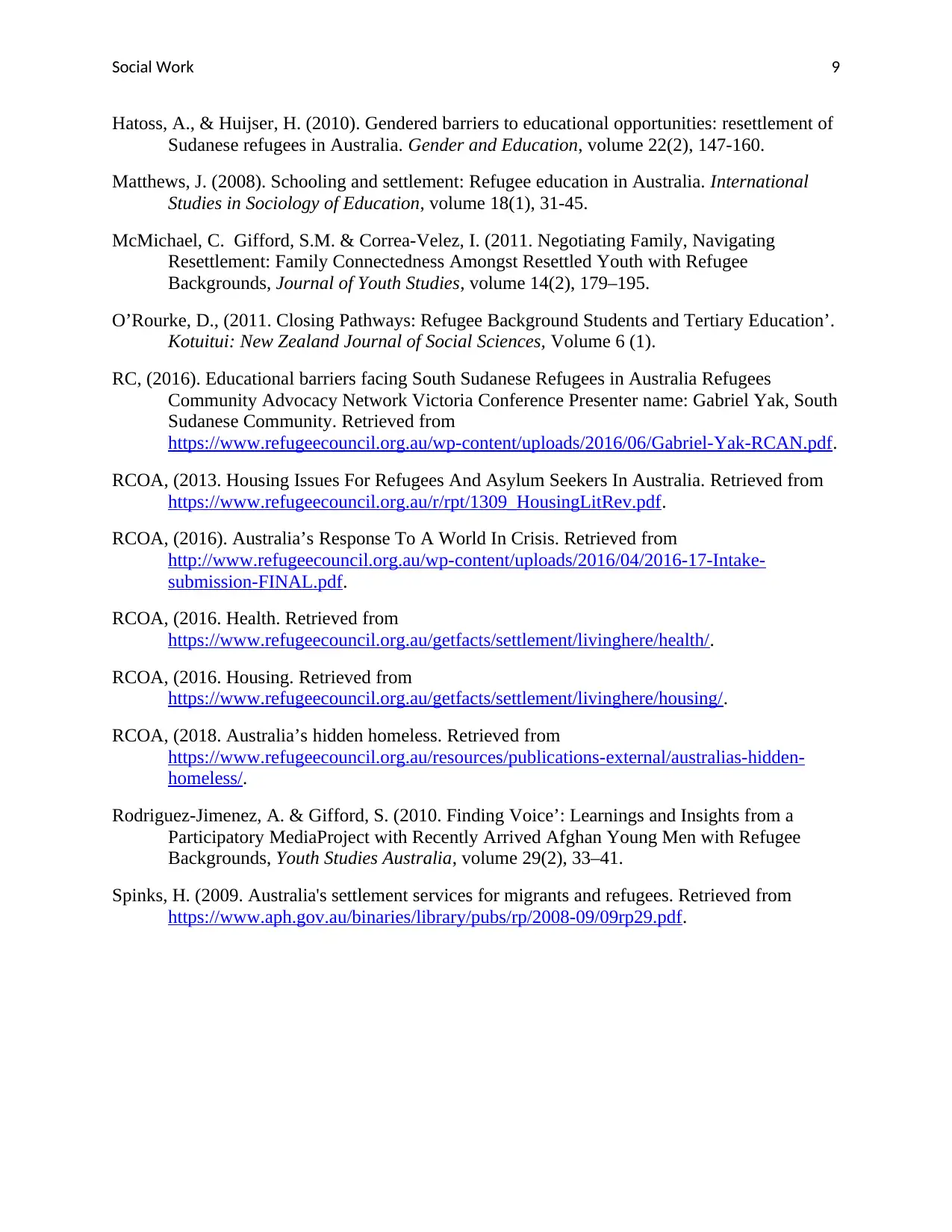
Social Work 9
Hatoss, A., & Huijser, H. (2010). Gendered barriers to educational opportunities: resettlement of
Sudanese refugees in Australia. Gender and Education, volume 22(2), 147-160.
Matthews, J. (2008). Schooling and settlement: Refugee education in Australia. International
Studies in Sociology of Education, volume 18(1), 31-45.
McMichael, C. Gifford, S.M. & Correa-Velez, I. (2011. Negotiating Family, Navigating
Resettlement: Family Connectedness Amongst Resettled Youth with Refugee
Backgrounds, Journal of Youth Studies, volume 14(2), 179–195.
O’Rourke, D., (2011. Closing Pathways: Refugee Background Students and Tertiary Education’.
Kotuitui: New Zealand Journal of Social Sciences, Volume 6 (1).
RC, (2016). Educational barriers facing South Sudanese Refugees in Australia Refugees
Community Advocacy Network Victoria Conference Presenter name: Gabriel Yak, South
Sudanese Community. Retrieved from
https://www.refugeecouncil.org.au/wp-content/uploads/2016/06/Gabriel-Yak-RCAN.pdf.
RCOA, (2013. Housing Issues For Refugees And Asylum Seekers In Australia. Retrieved from
https://www.refugeecouncil.org.au/r/rpt/1309_HousingLitRev.pdf.
RCOA, (2016). Australia’s Response To A World In Crisis. Retrieved from
http://www.refugeecouncil.org.au/wp-content/uploads/2016/04/2016-17-Intake-
submission-FINAL.pdf.
RCOA, (2016. Health. Retrieved from
https://www.refugeecouncil.org.au/getfacts/settlement/livinghere/health/.
RCOA, (2016. Housing. Retrieved from
https://www.refugeecouncil.org.au/getfacts/settlement/livinghere/housing/.
RCOA, (2018. Australia’s hidden homeless. Retrieved from
https://www.refugeecouncil.org.au/resources/publications-external/australias-hidden-
homeless/.
Rodriguez-Jimenez, A. & Gifford, S. (2010. Finding Voice’: Learnings and Insights from a
Participatory MediaProject with Recently Arrived Afghan Young Men with Refugee
Backgrounds, Youth Studies Australia, volume 29(2), 33–41.
Spinks, H. (2009. Australia's settlement services for migrants and refugees. Retrieved from
https://www.aph.gov.au/binaries/library/pubs/rp/2008-09/09rp29.pdf.
Hatoss, A., & Huijser, H. (2010). Gendered barriers to educational opportunities: resettlement of
Sudanese refugees in Australia. Gender and Education, volume 22(2), 147-160.
Matthews, J. (2008). Schooling and settlement: Refugee education in Australia. International
Studies in Sociology of Education, volume 18(1), 31-45.
McMichael, C. Gifford, S.M. & Correa-Velez, I. (2011. Negotiating Family, Navigating
Resettlement: Family Connectedness Amongst Resettled Youth with Refugee
Backgrounds, Journal of Youth Studies, volume 14(2), 179–195.
O’Rourke, D., (2011. Closing Pathways: Refugee Background Students and Tertiary Education’.
Kotuitui: New Zealand Journal of Social Sciences, Volume 6 (1).
RC, (2016). Educational barriers facing South Sudanese Refugees in Australia Refugees
Community Advocacy Network Victoria Conference Presenter name: Gabriel Yak, South
Sudanese Community. Retrieved from
https://www.refugeecouncil.org.au/wp-content/uploads/2016/06/Gabriel-Yak-RCAN.pdf.
RCOA, (2013. Housing Issues For Refugees And Asylum Seekers In Australia. Retrieved from
https://www.refugeecouncil.org.au/r/rpt/1309_HousingLitRev.pdf.
RCOA, (2016). Australia’s Response To A World In Crisis. Retrieved from
http://www.refugeecouncil.org.au/wp-content/uploads/2016/04/2016-17-Intake-
submission-FINAL.pdf.
RCOA, (2016. Health. Retrieved from
https://www.refugeecouncil.org.au/getfacts/settlement/livinghere/health/.
RCOA, (2016. Housing. Retrieved from
https://www.refugeecouncil.org.au/getfacts/settlement/livinghere/housing/.
RCOA, (2018. Australia’s hidden homeless. Retrieved from
https://www.refugeecouncil.org.au/resources/publications-external/australias-hidden-
homeless/.
Rodriguez-Jimenez, A. & Gifford, S. (2010. Finding Voice’: Learnings and Insights from a
Participatory MediaProject with Recently Arrived Afghan Young Men with Refugee
Backgrounds, Youth Studies Australia, volume 29(2), 33–41.
Spinks, H. (2009. Australia's settlement services for migrants and refugees. Retrieved from
https://www.aph.gov.au/binaries/library/pubs/rp/2008-09/09rp29.pdf.
⊘ This is a preview!⊘
Do you want full access?
Subscribe today to unlock all pages.

Trusted by 1+ million students worldwide
1 out of 9
Related Documents
Your All-in-One AI-Powered Toolkit for Academic Success.
+13062052269
info@desklib.com
Available 24*7 on WhatsApp / Email
![[object Object]](/_next/static/media/star-bottom.7253800d.svg)
Unlock your academic potential
Copyright © 2020–2025 A2Z Services. All Rights Reserved. Developed and managed by ZUCOL.





